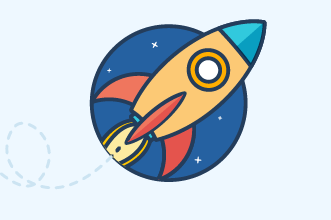
- >
- Workflow Platform >
- What is Agile Workflow? Steps to Create Agile Workflows
What is Agile Workflow? Steps to Create Agile Workflows
Team Kissflow
Updated on 13 Jun 2025 • 6 min read
Whatever business you are in, keeping up with the fast-paced changes in your industry is essential for business growth. You must be proactive in recognizing emergent changes in business processes, consumer needs, and other aspects of the business. Moreover, you must be capable of implementing the necessary actions to address these changes.
With most industries constantly evolving, many business organizations have begun to take the agile process flow approach to project management. Agile workflows help IT leaders enhance flexibility, accelerate project execution, and improve collaboration. Implementing them requires iterative development, automation, and continuous feedback for streamlined efficiency.
Effective agile workflow management enables teams to adapt quickly, enhance collaboration, and improve efficiency. If you haven’t adopted this approach yet, here’s a quick guide to help you understand the agile workflow model and how to implement it in your organization.
What is an agile workflow?
Agile workflow refers to managing and completing projects emphasizing flexibility, collaboration, and continuous improvement. It is based on the Agile software development methodology and is characterized by iterative and incremental delivery, adaptive planning, and delivery of working software.
At each sprint, customers and stakeholders provide their feedback, which is incorporated at the end of each sprint. This method enables developers to spot problems early on and fix them in a timely manner. It also improves the project’s efficiency and ensures that the final output meets the demands of the customers and stakeholders. Effective agile workflow management enhances team productivity and ensures seamless project execution.
Types of Agile Workflows
Here are the 6 types of agile workflows.
1. Feature-driven development:
Feature-driven development model is a progressive iterative process that focuses on developing core features in shorter, more frequent cycles.
2. Crystal:
This model follows a fluid method of development centered around humans and the requisites of the project.
3. Agile unified process:
An agile unified process is a simplified approach to product development that is easy to understand but stays loyal to the rational unified process that uses adaptable frameworks that tailor fit the needs of the development and project teams.
4. Extreme programming:
This is a process of agile product development that is completely dependent on reception and feedback from customers.
5. Scrum:
This is a popular subset of agile methodology that uses cross-functional teams to deliver specific pieces of functionality through repeatable approach.
6. Kanban:
Unlike other methods, Kanban is a non-iterative lean process that aims at delivering quality though keeping the backlog in check and effective team collaboration.
What is software development workflow?
A software development workflow is a sequence of steps that developers and engineers undertake to build, customize, deploy, and maintain software solutions and products.
Steps involved in an Agile Workflow Lifecycle

The agile methodology process flow generally follows a consistent structure across projects, ensuring a streamlined approach to project execution. Here are the typical agile methodology steps that guide teams in managing and delivering projects efficiently.
1. Ideation
The first stage is the conceptualization of the project. This is when you plan and envision your project. Here, you define the business scope for each idea, develop your product backlog, and delineate your sprints.
2. Inception
Once you have determined that a project is viable, you create sprint teams and assign their respective tasks. Each team is given a set of goals and a timeframe to complete them. It is also at this stage when funding and resources are allocated.
3. Iteration
With the project requirements set and working environments prepared, the sprint teams can now get down to business. The team starts working on the first iteration and tackles the product backlog items.
4. Release
After an iteration, the product is released to the customers and stakeholders for feedback. These are incorporated into the development then tested again before the next sprint. A QA team tests the functionality of the product so it can be corrected before the final release.
5. Production
Once all testing and documentation are done, the product is passed into the production phase. At this stage, the team ensures the successful launch of the product and provides support for its release. They may also be required to guide the users of the final product.
6. Retirement
The agile workflow process ends with the successful development of the product. It includes notifying the customers about the new product or the migration of the new software.
Implement agile principles in your workflow software for better project management.
How is agile workflow different from traditional workflow?
Both agile and the traditional waterfall workflow have their own advantages and disadvantages. However, most organizations prefer the agile methodology workflow today for its time efficiency and higher success rate.
To help you differentiate agile workflows vs traditional, here’s a quick peek at what their main differences are:
| Agile | Traditional |
| adaptive (flexible; responsive to changes during iterations) | predictive (follows a specific plan; not responsive to changes until the project is completed) |
| cyclic (work flows through a loop; enables going back to certain phases to make adjustments where necessary) | linear (work follows a sequential path where each phase must be completed before proceeding to the next phase) |
| customer-centric (enhances customer satisfaction by creating a product that meets their needs) | project-centered (the objective is to complete the project based on the plan formulated at the onset) |
| collaborative (customer is involved in every step of the project and can give feedback and request changes in each iteration) | contractual (a contract is negotiated and customers finalize requirements before development begins) |
How to create an agile workflow
To create your own agile workflow, you can follow these simple steps:
1. Adopt the right Agile practices
The Agile approach isn’t just about following a process. It involves a shift in mindset and an understanding of Agile principles. Help your team understand the rationale behind it so they can easily adapt to the new workflow.
2. Choose a framework
There are several types of agile workflow software you can utilize, including Scrum and Kanban. Determine which framework is most suitable for your organization.
3. Develop a roadmap
Create a strategy that can guide your sprint teams in achieving the project goals. Plan the process, develop product backlogs, and prepare agile workflow tools. Prioritize tasks and define timelines.
4. Assign sprint teams
Form sprint teams and define the roles of each member. Assign specific tasks and responsibilities. Ensure that each team has the expertise to complete their sprint.
5. Implement the agile workflow
With product requirements and sprint teams in place, you can start implementing your agile development workflow. Aim for continuous improvement and quick delivery time.
Future-proofed with an Agile Workflow
Prepare your organization for the future. Be more equipped to adapt to any changes in the business landscape. Implementing an agile workflow process for your project management gives you more flexibility and scalability for future growth. Kissflow Workflow offers agile and robust software that enables you to create seamless and efficient workflows. IT Developers and IT Heads need a faster way to build, deploy, and scale enterprise apps. With Kissflow’s low-code platform, coding complexity is reduced while flexibility remains
Solve your workflow challenges with Kissflow and optimize your team's productivity.
Create Your Agile Workflows in Minutes with Kissflow
Frequently Asked Questions
1. What is the Agile workflow process?
The Agile workflow process is a flexible and iterative approach to project management that prioritizes collaboration, adaptability, and continuous improvement. It involves breaking projects into smaller sprints, allowing teams to develop, test, and refine deliverables based on stakeholder feedback, ensuring efficiency and responsiveness to changing business needs.
2. What are the 5 steps of Agile?
The five key steps of the Agile methodology process flow are: Concept & Initiation, where project goals and teams are defined; Planning & Backlog Creation, which involves breaking tasks into user stories; Iteration Execution, where teams develop and test in sprints; Review & Feedback, where stakeholders provide input; and Continuous Improvement, where teams refine processes before the next iteration.
3. What is an Agile process flow example?
An Agile process flow example in software development starts with a feature request added to the backlog. The team selects tasks, plans a sprint, develops and tests the feature, and presents it to stakeholders for feedback. Necessary changes are incorporated into the next sprint, ensuring continuous refinement and improvement.
4. What is the difference between traditional and Agile workflow?
Unlike the traditional Waterfall model, which follows a linear process with fixed planning and late-stage feedback, Agile workflow is iterative, with continuous feedback, adaptive planning, and incremental delivery. Agile enables flexibility, faster development cycles, and the ability to accommodate changes, making it more efficient for modern projects.
5. What are the key principles of Agile workflows?
Key principles of Agile workflows include iterative development with continuous feedback, self-organizing cross-functional teams, time-boxed work cycles (sprints), prioritizing customer value, embracing change rather than following rigid plans, face-to-face communication when possible, sustainable pace of work, regular reflection on process effectiveness, and measuring progress through working deliverables rather than documentation.
6. How do Agile workflows improve efficiency?
Agile workflows improve efficiency by breaking work into manageable increments delivered quickly, enabling rapid adaptation to changing requirements, reducing waste through continuous feedback, empowering teams to solve problems creatively, minimizing unnecessary documentation, improving visibility through daily communication, and focusing resources on the highest-value activities first.
7. What industries use Agile workflows?
Industries using Agile workflows extensively include software development firms, digital marketing agencies, media and entertainment companies, fintech startups, and e-commerce businesses. Organizations facing rapidly changing market conditions, evolving customer requirements, and technical uncertainty gain the most from Agile's adaptive approach.
8. How does AI support Agile workflow implementation?
AI supports Agile workflow implementation by predicting project risks and potential delays, automating routine development tasks, analyzing user feedback to prioritize features, identifying patterns in development team performance, optimizing resource allocation across sprints, automating testing to maintain quality during rapid iterations, and suggesting process improvements based on historical sprint data.
9. What are common mistakes in Agile workflows?
Common mistakes in Agile workflows include treating Agile as a rigid methodology rather than adaptive, focusing on ceremonies over outcomes, creating unrealistic sprint commitments, neglecting technical debt, having ineffective or absent product owners, failing to involve stakeholders continuously, inadequate testing within sprints, and allowing scope creep despite timeboxed iterations.
“Creating workflows is significantly easier here than in other products. We have been able to successfully distribute the work to create workflows because of Kissflow”
- Ryan H
Thanks for submitting.
Our solution experts will connect with you to get started.
Related Articles











